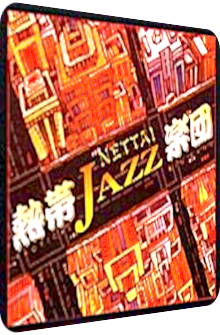
Nettai Tropical Jazz Big Band
My Favorite
2000
My Favorite is the third studio album – and fourth work overall – by bandleader Carlos Kanno’s Japanese collective of 17 musicians called the Nettai Tropical Jazz Big Band, released in 2000 on the RMM label and comprising of eleven tracks in total, with three of them specifically written by some band members for this album. It is the successor of the band’s magnificent LP September (1999) which united such diverse tunes as the Exotica classic Flamingo with the theme from Mission Impossible and material by the Pop band Earth, Wind & Fire. As the big band part of the ensemble’s name already implies, it is the brass instruments and horns that are in the limelight. While this is usually a less than optimal setup for exotic records, Kanno and personnel know how to rectify the situation with at least two important components in their interpretations. The first one targets the presumed limits of the brass instruments.
This is a Japanese band playing Latin music, and this means that the level of clichéd Latinisms is pretty low. The tone sequences are supercharged with cavalcades of colors, oftentimes unchaining a polyphony that is mind-blowing and even Space-Age-worthy. This fact alone makes the band’s albums somewhat – albeit not strikingly – exotic. However, this shortcoming is adjusted in a second step, comprising of a wealth of percussion instruments played by four dedicated percussionists, among them Carlos Kanno. Cowbells, congas, bongos and other South American devices add verdure to the bronze instruments. My Favorite draws from a similar wealth of material as September or its own follow-up La Noche Tropical (2001), and while most of the songs are uptempo and ebullient, there are very dreamy mélanges on board as well. Here’s a closer look at the eleven tracks as well as the good sides and bad sides of the album.
Fire! Or so it seems. The aggressive-effervescent brass stabs of the opener Época De Oro slide through the (head)room like incisive shards. Envisioned by Ken Morimura and translatable as the golden era, the Nettai Tropical Jazz Big Band does not waste any time and unleashes a gorgeously warm, polylayered and uplifting Latin hymn with a dense thicket of cowbells, hi-toms and bongos played by bandleader Carlos Kanno himself who is backed by Michiaki Tanaka. Salt Shionoya’s bubbling and wonderfully liquedous piano spirals underline the lead trumpet and thicket of brass instruments. Thankfully, Kanno’s interpretation leaves enough room for a long segue of percussion prowess before the positively oversaturated Samba structure returns one more time. A sunny bit of greatness.
The band’s take on Oscar Hammerstein II and Richard Rodgers’s My Favorite Things then moves into metropolitan Space-Age climes, with the interplay becoming more eclectic, the mood curiously aeriform and show tune-like, the feeling of being in a bustling city is augmented without forgetting about the tropical greeneries in-between the erections of brazen brass horns. Oscillating between a purposefully smarmy big band timbre and maelstroms of contemporary neo-eclecticism, it is no wonder that the band named their album after this tune. It may be convoluted, but also eminently accessible, with its many textures and tonal changes swooshing by and thus creating a gleeful fluxion that is utterly enchanting and spacey.
David Foster’s and David Paich’s Got to Be Real is next and expands the theme of insouciance and carefreeness without giving in entirely to an all too glitzy mood. The brass eruptions are typically Japanese in that the horns are comparably Disco-oid, but always traversed by jazzy particles such as Samba cowbells, groves of bongos and Shionoya’s aerose piano rivers. The tempo does not change, but the rhythms do and evoke a string of lively vignettes that are all tied together by the mirthful mood. A bubbling corker with the appropriate amount of megalomania at the right time. Louis Prima’s Sing, Sing, Sing offers a new mood range for the first time, for the Nettai Tropical Jazz Big Band unites the Yiddish tonality of festive songs with the hot-blooded flames of Latin lamentos. Pianist Salt Shionoya plays the piano in that archetypically Latin way for the first time on the album. The neck-breaking tempo is further boosted by the mixed choir of band members who sing the Spanish lyrics in a rather doleful, less exhilarative way. Not a murky piece per se, Sing, Sing, Sing pours Carlos Kanno’s love for all things Latin into each note. If it were not for the choir and the dense tropical percussion, the Japanese band would have walked into the cliché trap.
Band member and trombonist Taisei Aoki’s ¿Por Que No? meanwhile is an utter delight due to its sunset-like midtempo gentleness that is further fueled by rural accordion arabesques and a specifically silkened music-related dialog between the band members. The piano segue is noteworthy for the soothing brass susurration and glittering bongo vesicles. After all the quirky and rapidly fired material, this breather offers a nice counterpoint qua its lilac ambiance and embracing aura. Rocks by The Brecker Brothers receives the same tropical treatment, but it is a transmutated one, with brightly lit hues, neon colors and silver glitters. The repetition of the rising four-to-six-note horn catchiness right at the beginning shows this better than anything else, and if that is not enough, wonky wah-wah Funk guitars and heavy drums round off the glamour of this composition. Lots of fissured cracks in-between the tones allow a complex mechanism of decay, sustain, afterglow and textural variety.
Herb Alpert’s Bitter Sweet Samba is next, renamed by Kanno to Bitter Sweet Bomba, and rightfully so, for the trumpets, trombones and saxophones blast everything away with their stereotyped Latin attitude. A typical critter torn between tones in minor and aqueous blebs of joy, the main melody is curiously neglected during most of the song’s runtime. This one is a disappointment to me. While trombonist and band member Hideaki Nakaji’s Ruinas brings his talent into the spotlight and unites it with his fellow brass players but lacks memorable melodies and is too labyrinthine and jazzy in regard to the album’s overarching theme (and in terms of the band’s name!), Marcel Eugene Ageron’s and Mack David’s Cherry Pink And Apple Blossom White finally features Carlos Kanno as the lead vocalist in a superb rendition of a classic that gets deschmaltzified by featuring beautiful alto flute helixes next to green-tinted percussion layers and piano undulations fueled by a moist glissando.
I Can’t Stop Loving You by Glen Barbee, William Shelby and Stephen Shockley is the second major disappointment of the album, at least if it is viewed through rose-tinted Exotica glasses. There is anything particularly paradisal about it. Skillful it is, but there is no yearning evoked. This, however, is accomplished by the closer Prende El Fuego with its cowbell-fueled percussion prelude through which various brass stabs cut in tandem with Latin piano billows. Tempo shifts, admixed bongos and a growing four-note brass leitmotif that culminates into luminescent multilayered explosions finish the wide array of material with a bang.
The music of the Nettai Tropical Jazz Big Band is never solely about Exotica, but most of the time, the material is wonderfully tropicalized by the band, no matter the source, genre or songwriter of the original. And so My Favorite depicts a wonderful potpourri of songs and spices these with three original cuts. The utter focus on the various brass instruments is usually a problem in the realms of Exotica, for these instruments are not particularly dreamy. However, the Japanese do it better! My Favorite and all other albums by the band inject huge doses of euphony and electrifying harmonies into the chords and elevate this album into elysian heights, letting it tower above bog-standard big band artifacts.
The amicable harshness, benign power and friendly shadiness make the aural journey particularly attractive, whether it is the elimination of cobwebs in a kick-ass take on Cherry Pink And Apple Blossom White with Carlos Kanno at the helm vocal-wise, the languorous non-Latin phantasmagoria in ¿Por Que No? or the magnificent abundance of ever-changing vignettes in My Favorite Things, the textures of the brass instruments is iridescent and vivacious, in fact so much so that the more earthbound tunes feel even more disappointing. Even though the principal pool of instruments could be decidedly widened – an alto flute appears in one tune only –, it is Salt Shionoya’s piano sparks and the ubiquitous percussion placentas which ennoble the arrangements, the latter of which make it easy to link the album to exotic shores. That this album is not available in digital music stores, let alone worldwide is, as I tend to say, a crime. And I do not approve of crimes when an album is this good. Maaaaybe the rightsholders and record company care about this opinion?
Exotica Review 368: Nettai Tropical Jazz Big Band – My Favorite (2000). Originally published on Aug. 23, 2014 at AmbientExotica.com.
